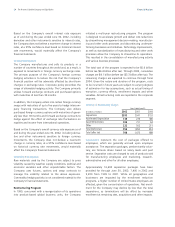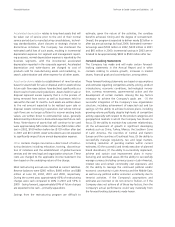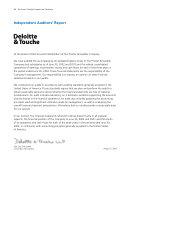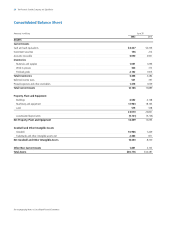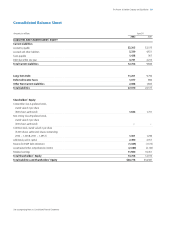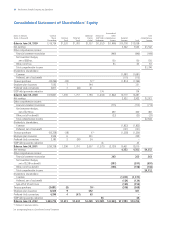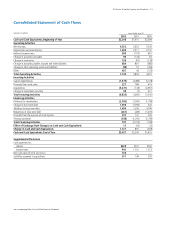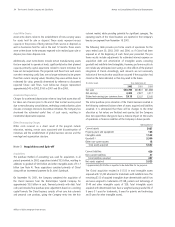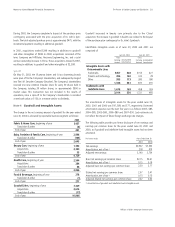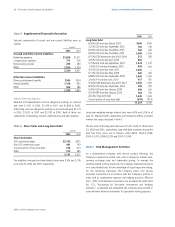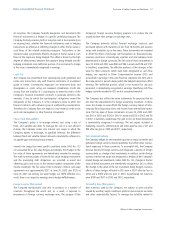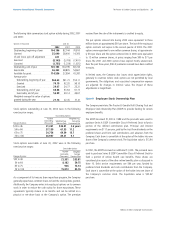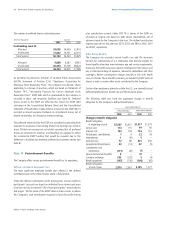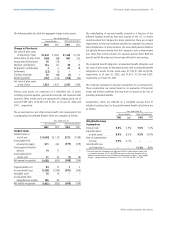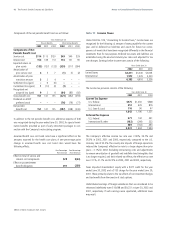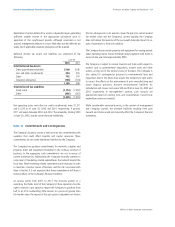Proctor and Gamble 2002 Annual Report Download - page 35
Download and view the complete annual report
Please find page 35 of the 2002 Proctor and Gamble annual report below. You can navigate through the pages in the report by either clicking on the pages listed below, or by using the keyword search tool below to find specific information within the annual report.
Millions of dollars except per share amounts
33The Procter & Gamble Company and Subsidiaries
indefinite-lived intangibles are evaluated annually for impairment.
Beginning in 2002, such determination of fair value is based on
valuation models that incorporate expected future cash flows and
profitability projections. Prior to 2002, goodwill was amortized over
periods not exceeding 40 years.
Property, Plant and Equipment: Property, plant and equipment are
recorded at cost reduced by accumulated depreciation. Depreciation
expense is recognized over the assets’ estimated useful lives using the
straight-line method. Estimated useful lives are based on Company
averages and range from 3 to 20 years for machinery and equipment
and 40 years for buildings. Estimated useful lives are periodically
reviewed and, where appropriate, changes are made prospectively.
Fair Values of Financial Instruments: Fair values of cash equivalents,
short- and long-term investments and short-term debt approximate
cost. The estimated fair values of other financial instruments, including
debt, equity and risk management instruments, have been determined
using market information and valuation methodologies, primarily
discounted cash flow analysis. These estimates require considerable
judgment in interpreting market data, and changes in assumptions or
estimation methods could significantly affect the fair value estimates.
Reclassifications: Certain reclassifications of prior years’ amounts have
been made to conform to the current year presentation.
Note 2 Restructuring Program
In 1999, concurrent with a reorganization of its operations into
product-based global business units, the Company initiated a multi-year
restructuring program. The program is designed to accelerate growth
and deliver cost reductions by streamlining management decision-
making, manufacturing and other work processes and discontinuing
under-performing businesses and initiatives. Technology improvements
as well as standardization of manufacturing and other work processes
allow the Company to streamline operations, resulting in the consolida-
tion of manufacturing activity and various business processes.
Costs to be incurred include separation related costs, asset
write-downs, accelerated depreciation and other costs directly related
to the restructuring effort.
Due to the nature of the charges and the duration of the program,
estimates of the timing and amount of costs and savings require
significant judgment and may change over time. Based on current
estimates, the overall program is expected to result in total charges of
$5.6 billion ($4.4 billion after tax) over the six-year period that began in
1999. Through 2002, cumulative charges are $4.1 billion ($3.3 billion
after tax). Under current accounting rules, many restructuring charges
may not be recognized at project initiation, but rather are charged to
expense as established criteria for recognition are met. This accounting
yields ongoing charges over the entire restructuring period, rather than
a large reserve at initiation.
Before-tax restructuring activity was as follows:
Charges for the program are reflected in the corporate segment.
Separation Costs
Employee separation charges relate to severance packages for
approximately 7,400 people in 2002, 6000 people in 2001, 2800
people in 2000 and 400 people in 1999. The packages are predomi-
nantly voluntary and are formula driven based on salary levels and past
service. Severance costs related to voluntary separations are charged to
earnings when the employee accepts the offer. The current and planned
separations span the entire organization, including manufacturing,
selling, research and administrative positions.
Notes to Consolidated Financial Statements
TotalOther
Accelerated
Depreciation
Asset
Write-Downs
$44
814
(320)
(450)
88
1,850
(385)
(1,093)
460
958
(813)
(360)
245
$9
211
(220)
–
–
502
(199)
(86)
217
222
(336)
(17)
86
$ –
386
–
(386)
–
276
–
(276)
–
135
–
(135)
–
Separations
$35
153
(100)
–
88
341
(186)
–
243
393
(477)
–
159
$ –
64
–
(64)
–
731
–
(731)
–
208
–
(208)
–
Reserve balance
June 30, 1999
2000:
Charges
Cash spent
Charged against
assets
Reserve balance
June 30, 2000
2001:
Charges
Cash spent
Charged against
assets
Reserve balance
June 30, 2001
2002:
Charges
Cash spent
Charged against
assets
Reserve balance
June 30, 2002



